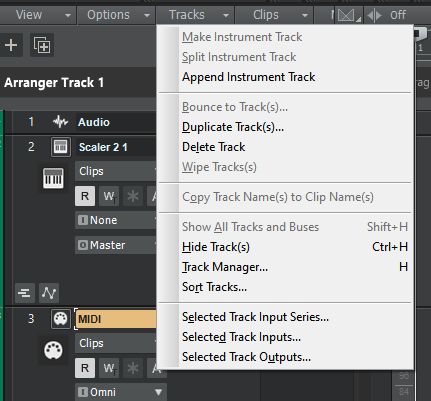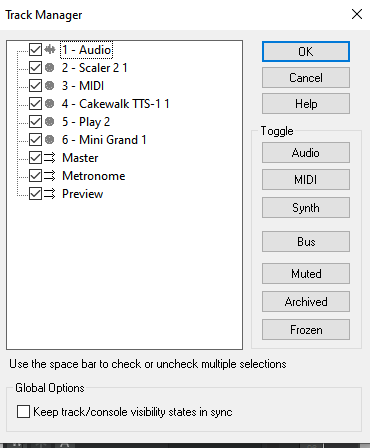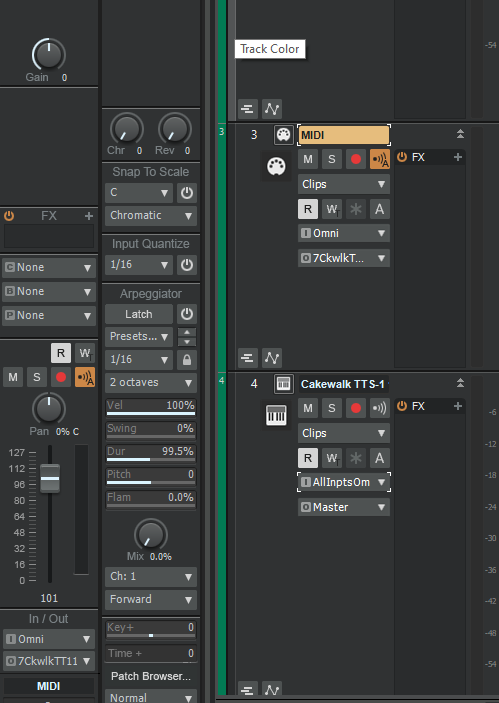-
Posts
242 -
Joined
-
Last visited
-
Days Won
1
Everything posted by Steve Harder
-
This wasn't a Cakewalk issue. This morning I had downloaded Scaler 2.1.1. It breaks doubleclick functions in Cakewalk. Reinstalled Scaler 2.1.0 and all is normal. I was too quick to blame the Win10 2004 update of yesterday. I am used to editing a track name by selecting the track and double clicking on the track name and seeing it change to white background with smaller blue text. I updated to Win10 2004 yesterday. This morning in Cakewalk I cannot edit a track name in the track view by selecting and double clicking it. There is a slight blink but no change to white background. This happens in all my previous projects. If I create a new project then editing track name works as normal. I've tried saving-as previous projects but problem persists. Googled but couldn't hit on answer. Weird ... I have restarted PC, etc. I haven't noticed any other problems with other software or within Cakewalk. Adding some details ... Open newly created project where track name editing is ok. Open previous project where track name editing fails. Use Window to switch between the two. Use Window to switch to new project. Double click and edit track name. OK Use Window to switch to previous project. Double click track name and editing is OK. Press return and attempt double click to edit but doesn't work on the 2nd attempt. Now use Window to open the new project. Double click track name to edit, it fails. Then double click track name to edit and it works. Weirder ... And more symptoms. I did try several different mice, all act the same. This is an issue with handling double-clicks. Same scenario as above. Use window to switch to new project where track edit works OK. Select File Open and then double click on file name in directory. File opens. Use window to switch to previous project where track edit fails. Select File Open and then double click on file name in directory. File is selected but you have to then click on Open box. So doubleclick was ignored. I have visited Mouse Properties and tried different Double Click speeds. They act correctly in Mouse Properties and in other softwares.
-
I know it's very early days and we've only gotten a vid that hints at articulation maps and how they will work. Hopefully developers will be able to provide a means of importing data into the template editor. And exporting to share with other users. This is a link to one approach to community supported creation of articulation maps. https://vi-control.net/community/threads/universal-daw-articulation-manager.95959/#post-4621970 Having a means of leap frogging off the work of others could make it easier for Cakewalk users to get started with maps.
-
There is a lot of sharing going over on vi-control.net. Here's a link to a discussion on a spreadsheet that can then be used to generate templates for daws that have articulation maps. That spreadsheet currently contains listings of the triggering details for many libraries, so it would save a lot of work getting started. Once we get insight into how Cakewalk maps will function I'll look at getting the spreadsheet to generate Cakewalk maps. The power of this is one open source master spreadsheet, easily updated as new libraries come out, can used to generate articulation maps for Cubase, Logic, Reaper and eventually Cakewalk. https://vi-control.net/community/threads/universal-daw-articulation-manager.95959/#post-4621970 Early days but I'm looking forward to help making this happen. Finally an opportunity to put my database programming skills to work on music.
-
I have Ozone Elements 9. It takes a 2 or 3 secs to load, didn't seem to be out of the ordinary for me.
-
Another 3 days and NO dropouts. Nice to be able to have internet while working on heavy projects. I'm almost ready to declare total victory!
-

Midi channel select not displayed in track view.
Steve Harder replied to Steve Harder's question in Q&A
THANK YOU! Track Control drop down was set to Custom. And it's likely that the Shift + left or right arrow shortcuts were where I stumbled. I use left right arrow for a number of things and probably just threw a press of the Shift key into the mix, probably "Shift-ed" when I should have "Alt-ed", or whatever. And I now have another small world to explore in the Track Control Manager. The devil is always in the details. Thanks once again for taking the time to guide me to the solution. I always try to google and search first, but this time I couldn't come up with the correct search terms to get me my answer, so discuss.cakewalk came thru again. -

Midi channel select not displayed in track view.
Steve Harder replied to Steve Harder's question in Q&A
-

Midi channel select not displayed in track view.
Steve Harder replied to Steve Harder's question in Q&A
My workspace is selected as Advanced. And within the Workspace Manager literally every checkbox is checked. I tried applying a couple of the other workspaces but no change. Thinking back, this change might have happened when I updated to the 2020.08 but it's more likely something I've inadvertently changed. I had been working existing projects, so didn't really notice this until I started a couple of new ones and was Inserting new instruments. -
I've searched and googled and haven't hit the answer. I've changed a config somewhere. Here I have a TTS-16 , a instrument with 16 inputs inserted in a simple instrument track. And I have a Midi track selected. Previously, in the Track View (to the right of the green divider), in the area just below the output selection tab (which current reads &CkwlkT...), I would have another selection tab that would let me select from the 16 midi channels. That allowed me to assign instrument and channel in the same location. Yes, I can select the Instrument channel in the midi tab to the left using the topmost of the the 3 "None" selectors. But how have I made the Channel selection disappear in the right hand Track view display?
-
FWIW I had previously stopped audio engine dropouts by disabling all my network adapters. After I read the quoted thread above I disabled DellSupportAssistRemediation. For the past 3 days I have left my network adapters enabled and have had no audio engine dropouts. This isn't a long enough test to be confident in the result, but previously I would never have gone multiple days without engine dropout with network enabled. Hoping this works because having network always available is very convenient. YMMV
-
Try disabling your network adapters, both ethernet and wifi, while in your daw. That totally stopped my audio engine dropouts. Yes, it's a hassle but worth it. You can set up shortcuts to batch files that make it pretty easy.
-
Also be sure to turn off any real time virus scanning on folders or drives that contain samples.
-

Feature Request - Color Trigger Keyswitches Articulation ISs
Steve Harder replied to sadicus's topic in Feedback Loop
I learned a lot by watching that entire vid. I have several takeaways. Using expression maps requires a lot of thoughtful and detailed work to create useable templates. You don't just snap your fingers and magic happens. The "high hill" that I assumed the programmers would need to climb to incorporate expression maps is really a "mountain". That means it is important to wait patiently for progress to happen. -

Feature Request - Color Trigger Keyswitches Articulation ISs
Steve Harder replied to sadicus's topic in Feedback Loop
This is another request for expression maps in Cakewalk from an owner of TwelveTone Cakewalk. -

Expression map workarounds in Cakewalk?
Steve Harder replied to Steve Harder's topic in Cakewalk by BandLab
I do own some VSL Synchron libraries. But the VSL site says that Synchron based libraries are not compatible with Vienna Instruments Pro. Am I correct? -
I love Cakewalk. Used it back in Twelvetone days and rediscovered it after retiring. Returning after 15 or so years to the much richer vst sample library world has been quite a treat. I've now reached the level of work in orchestral libraries where articulations are used constantly. I've researched and tried using drum maps as a means of selecting artics but it is kludgy and not straightforward to implement. And I've watched with some envy vids of expression maps being used in Cubase and other daws. Expression maps could be the feature that would pull me away from Cakewalk. So I'm seeking suggestions from a Cakewalk user who has an effective process to control orchestral articulations that somewhat mimics expression maps. As Thomas Jefferson asks in Hamilton "What'd I miss?" Thanks
-
In piano roll, drawing in modulation or expression curves, I'd like to hear how the instrument is responding in real time. Am I drawing a mp or a mf or a ff? I watched a tutorial In Cubase there is a note expression panel. You select notes that you want to affect. You open the "note expression panel" and select CC. You draw in your data and while you are drawing the instrument plays and responds to your CC data. It seems to be a very efficient way to input CC data, especially for those of us whose keyboard skills are lacking. No way I can play and control CC at the same time, so drawing in after playing is my only option. Skip to 4:00, as he says "It's magic".
-
I've been getting up to speed in Scaler2. The 2 parts of this tutorial really prep you to explore the new progressions section. Not an overly edited video, just thoughtful sharing of info from someone who seems to know chord theory.
-
Worth a watch if you have Scaler, it uses Scaler 1 but all applies to Scaler 2. And gives you solid background for new Scaler2 modal features. This tutorial really stuck concepts into my mind. It is long but worth the time. Uses Scaler to demo some basic but deep and detailed chord theory. And for more modal theory.
-

Scaler2 and Cakewalk step recording
Steve Harder replied to Steve Harder's topic in Cakewalk by BandLab
Thanks, I'll try the Playback Quantitize. I think Scaler 2 has saved me a lot of money. Now I've been spending most of my time with my owned libraries, discovering tons of new paths for composition. And not spending time pondering purchase of new libraries with the hope that they will kick start new ideas. -

Scaler2 and Cakewalk step recording
Steve Harder replied to Steve Harder's topic in Cakewalk by BandLab
Thanks for the quick and objective reply. -
I'd like to use Cakewalk step recording and Scaler2 to create ostinato patterns easily. I can route Scaler2 midi to a target Midi track by assigning midi track input to Scaler2. And successfully record Scaler2 output, with single note key press in Scaler2 producing multiple note chords or chord assigned single notes in the target midi track. But step recording seems to grab it's input directly from the midi controller keyboard rather than the input that is associated with the target midi track. My goal is the results I get in the previous successful Scaler2 recording, but processed by the step recorder . What I end up with is the step recorder processing the keys I am pressing on the midi controller, as though Scaler wasn't involved. I have not yet explored using an external midi router app. I can capture midi in Scaler2, but those notes are not tidily laid out as 1/16s with identical note duration. Just wondered if anyone else has wandered the step recording path and might be able to offer some insights. Thanks





